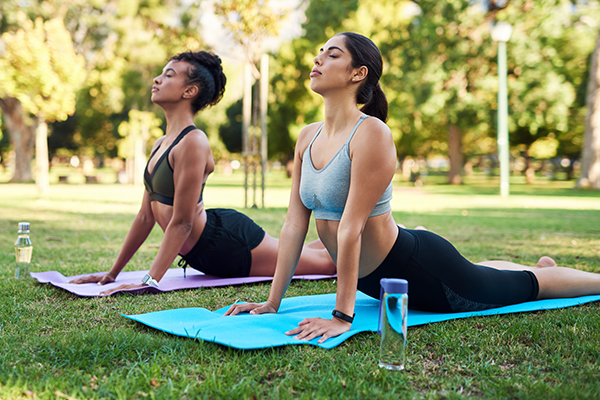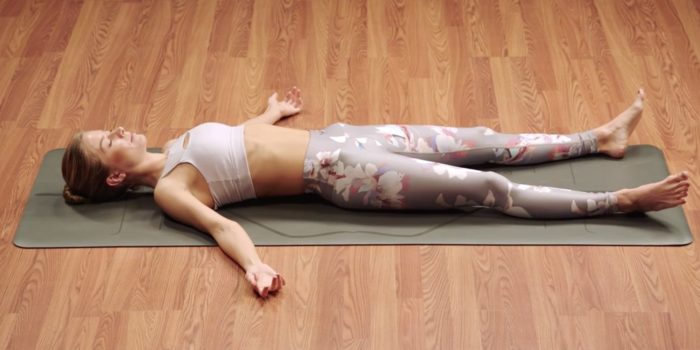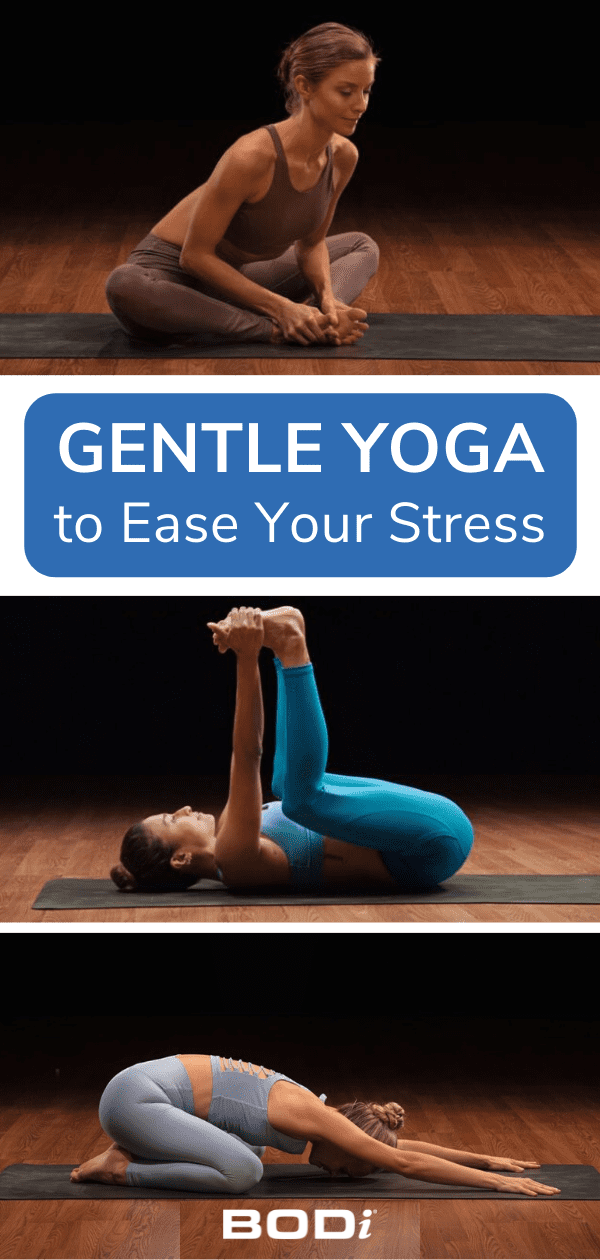If you happen to assume yoga is all about handstands and contorting your physique into near-impossible poses, you must know that there are a number of other ways to observe yoga. Mild yoga, for instance, is acceptable for nearly anybody, newcomers and veterans alike.
“Mild yoga presents a nurturing and compassionate strategy to the physique,” says Sarah Cummins, RYT 500, E-RYT 200, YACEP, yoga teacher and licensed private coach. “It’s typically taught in a means that every one individuals can simply take part.”
What Is Mild Yoga?

Mild yoga is a sluggish, tranquil observe through which you sometimes maintain poses for prolonged intervals of time.
“Mild yoga could be taught in quite a lot of methods, primarily based in your teacher’s yoga model or lineage and expertise,” Cummins says. “Mild yoga could mix a sluggish stream with longer-held restorative positions that always embody an emphasis on the breath in addition to meditation practices.”
Whereas every class will range, right here’s what you may count on in a mild yoga class in keeping with Cummins:
- Cues on methods to safely and adequately align your physique.
- Suggestions to make use of props akin to blocks, straps, blankets, and bolsters to assist with alignment and rest.
- Fewer transitions from sitting to standing or kneeling to mendacity down for a smoother, extra relaxed expertise.
- A number of choices and modifications to “meet you the place you’re and go away house in your exploration of poses,” she says.
Kinds of mild yoga
Some yoga studios provide “sluggish stream” courses which are a gentler type of vinyasa yoga. And restorative yoga and yin yoga are each thought-about “mild” yoga practices.
Whereas each restorative yoga and yin yoga are mild on the physique, there are some variations between the 2 types:
Restorative yoga: Incorporates roughly 5 – 6 postures which are meant to decelerate and restore the physique. Every pose is held for a pair minutes, utilizing a number of props for help. The purpose is complete consolation so that you just launch all rigidity out of your muscle tissues.
Yin yoga: Holds fewer poses for longer intervals (three-to-five minutes), however “you’re penetrating to the deepest layers of connective tissue to convey elasticity, mobility, and vitality again to tight muscle tissues. Most yin poses are accomplished solely on the ground and can more than likely really feel more difficult than these in restorative yoga,” Cummins says.
Is Mild Yoga Good For Rookies?
Mild yoga is a wonderful entry level to yoga for newcomers. “Mild yoga permits college students to maneuver by postures slowly and mindfully and observe yoga in a protected and efficient means,” Cummins says.
However it’s not solely for newbies.
“It’s a rewarding observe for the younger and previous, the versatile and rigid. It’s additionally nice for pregnant girls and people recovering from damage,” she provides.
Mild Yoga Sequence
Mild yoga could embody a mix of reclining, seated, and even standing or balancing poses. It’s easy to make any yoga observe gentler by including props, not going as “deep” right into a pose, or transferring extra slowly.
Together with extra intense flows, Yoga52 and Beachbody Yoga Studio on BODi each provide soothing practices that you are able to do at dwelling to wind down from an extended day at work, quiet down after a exercise, or prepare for mattress.
If you happen to’re trying to create your personal stream, listed here are some poses to strive.
1. Mountain pose (Tadasana)
- Begin standing together with your huge toes touching and your heels barely aside. Your arms ought to relaxation by your sides, palms going through ahead.
- Interact your thighs and lengthen your tailbone all the way down to create an extended backbone.
- Carry your chest and draw your shoulder blades again and down.
- Maintain your ears over your shoulders and your pelvis over your ankles.
- Take a number of deep breaths (contemplate holding for one minute).
2. Standing ahead bend (Uttanasana)
- Begin in mountain pose together with your ft hip-distance aside (or barely wider). Place yoga blocks on the mat in entrance of your ft. Take a deep breath.
- Exhale, bend your knees barely, hinge at your hips, and relaxation your palms on the blocks.
- Look towards your legs and bend your knees as a lot as you need or want.
- Shift your weight ahead to align your hips over your heels.
- Keep right here for no less than three breaths.
- Take a breath and rise again as much as standing. Press down together with your ft and pull your low stomach in to help your decrease again as you unfold.
3. Little one’s pose (Balasana)
- Begin in your mat on all fours. Place your palms instantly under your shoulders and your knees beneath your hips. Deliver your huge toes collectively.
- Sink your hips again towards your heels. Relaxation your stomach between your thighs and contact your brow to your mat.
- Lengthen your arms in entrance of you. Choice to succeed in your arms behind you and cup your heels.
- Keep for a number of breaths/minutes.
4. Cat-cow stretch (Bitilasana and marjaryasana)
Inhale: Cow pose
- From little one’s pose, come again to all fours. Maintain your again flat, your neck lengthy, and your gaze towards the ground.
- As you inhale, carry your tailbone and chest towards the ceiling whereas dropping your stomach towards the mat.
- Draw your shoulders away out of your ears. Squeeze your shoulder blades, and carry your head consistent with your torso.
- Exhale into cat pose.
Exhale: Cat pose
- From cow pose, exhale, spherical your backbone, tuck your tailbone, and curl your chin towards your chest.
- Inhale into cow pose.
- Repeat this stream for as much as 10 breaths, or longer if desired.
5. Seated ahead fold (Paschimottanasana)
- Come to a seated place in your mat.
- Sit tall together with your legs prolonged in entrance of you. Flex your ft. Relaxation your palms at your sides on the bottom.
- Soften your knees (possibility to position a blanket beneath your knees).
- Draw your abs in and hinge at your hips to fold over your thighs. Stroll your palms down your legs towards your ft. Keep away from rounding your again or utilizing your arms to drag your self into the pose.
- Maintain for 5 or extra breaths. With every exhale, attempt to chill out into the posture to get a deeper stretch. Come again up on an inhale.
6. Sure-angle pose (Baddha konasana)
- Sit in your mat together with your sit bones instantly beneath you (keep away from tucking your tailbone).
- Contact the soles of your ft collectively. Open your knees huge like a e-book (possibility to slip two blocks beneath your knees you probably have any knee rigidity).
- Slide your heels as near your groin as comfy.
- Relaxation your thumbs on the balls of your ft. Wrap the remainder of your fingers across the tops of your toes.
- Sit up tall. Maintain your gaze ahead, and your chest open.
- If you wish to deepen the stretch, hinge ahead at your hips with out rounding your again.
- Maintain for no less than 5 breaths or one minute.
7. Glad child pose (Ananda balasana)
- Lie down in your mat. Bend your knees and flatten your ft on the mat.
- Hug your knees to your chest. Deliver your knees to your chest and seize the outer edges of your ft.
- Pull your knees towards your armpits.
- Compress your tailbone to the mat (choice to rock side-to-side).
- Keep for a number of deep breaths.
8. Corpse pose (Savasana)

- Lie down in your mat.
- Let your arms relaxation barely away out of your torso, together with your palms going through up. Chill out your shoulders away out of your ears.
- Separate your legs till your heels attain the corners of your mat.
- Shut your eyes, and chill out your total physique as you sluggish your respiration and relaxation for no less than 5 minutes.


